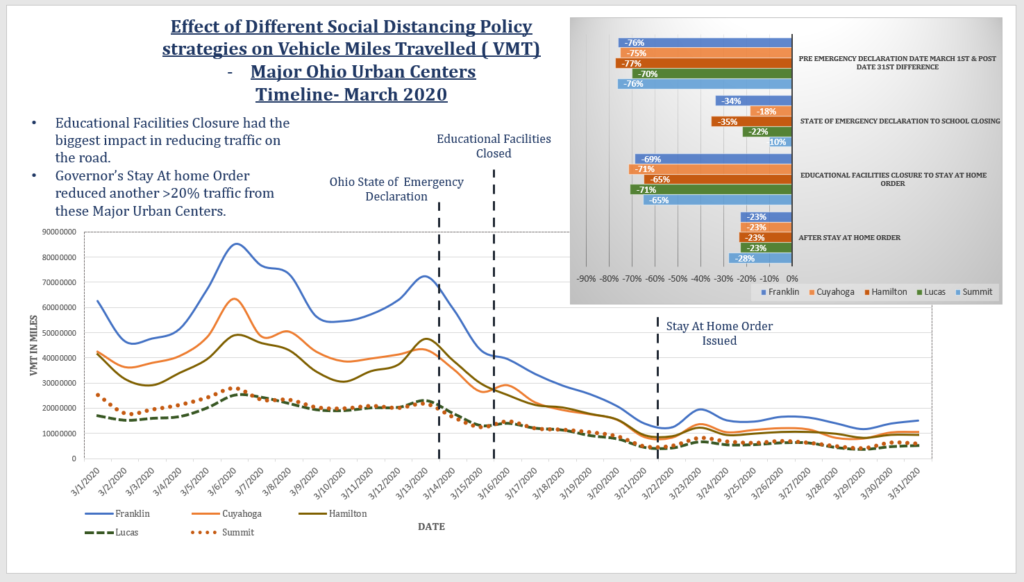Impact of “Covid -19” spread in travel pattern of BHJ Region
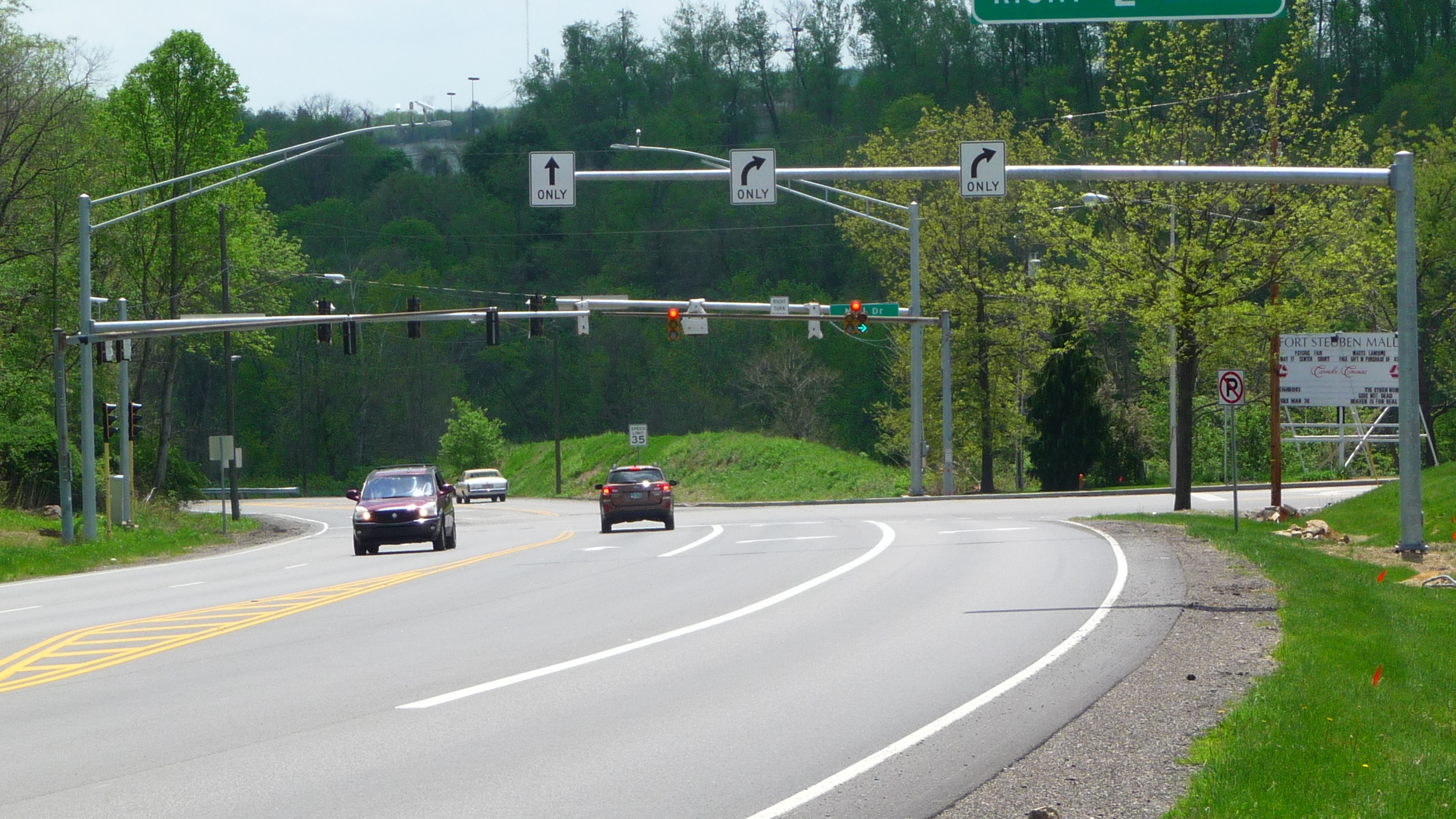
Background
Travel to — and throughout — the United States has rapidly dropped in recent days, driven by concerns about the spread of the novel coronavirus and, of course, the BHJ region and Ohio Valley is not immune. Though the level of spread is still minimum in this area, this pandemic took a heavy toll in the daily commuting pattern. To understand this changing trend and what is driving the travel behavior of people in our community, BHJ recently completed a study comprising various sources of primary and secondary data collecting from private venders like @Google, @Streetlight and @Unacast and also from traffic signal count station inside City of Steubenville, Ohio. This Study considered the month of March, 2020 as the study timeline.
Effect of Different Social Distancing Policy Strategies on Vehicle Miles Travelled (VMT)
Overall, from beginning of March, the Vehicle Miles Travelled (VMT) decreased by over 60%. Rather than governor’s Stay at home order, school closure played a significant role in this reduction. Both sides of the Ohio River (the BHJ counties of Ohio and West Virginia) observed a VMT reduction of over 50% when their respective educational institution closed. But after each state issued the stay at home order, the reduction rate was minimum. In fact, Hancock county observed an increase of 7% VMT greater than the period before the stay at home order. As educational institutions play a major role in the economy and employment distribution of BHJ region, its major impact comes as no surprise. However, per the Stay at home order classifies the other major employment sectors of this region such as healthcare, manufacturing, and government sector as essential work. Therefore, the reduction rate after taking out all the educational and its related trips is minimum. Excluding the large drop of VMT school and school-related activity trips on March, 14th -16th, weekly travel habits are static except for peak grocery trips on Friday or Saturday.
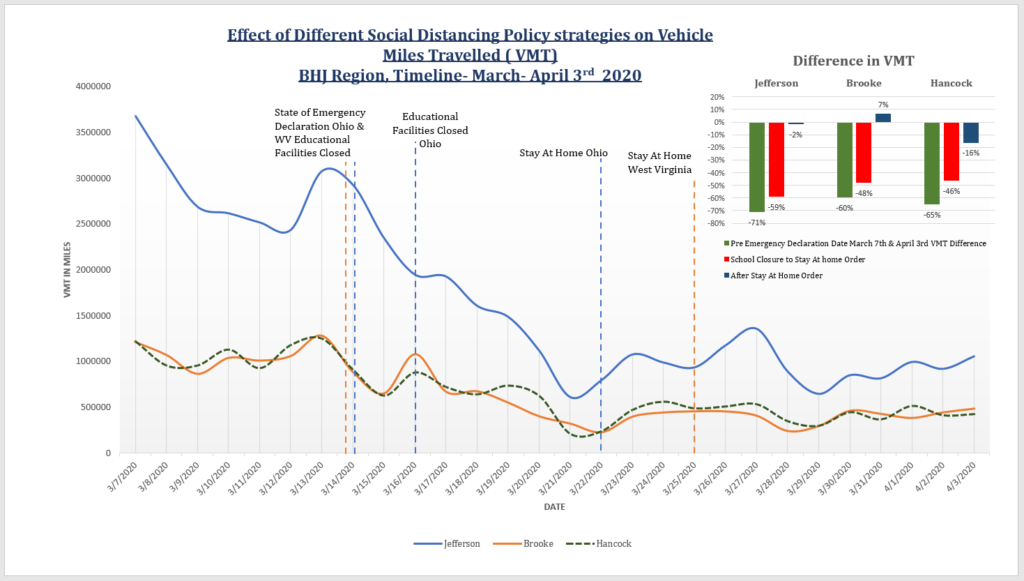
Case Study Location – SR 43 & John Scott Highway Intersection
To better understand this decreasing trend of VMT, this report conducted a micro scale study by collecting traffic signal data from a high-traveled intersection in Steubenville, OH – SR 43 & John Scott Highway. This study collected the 1st and last week data of March, 2020 and found a significant decrease in vehicle numbers. The difference is minimum on Saturday and consistently higher in the middle of the week. As grocery trips are exempt from the stay at home orders, much of the public appears to be making those trips on either Friday evening or Saturday. Since Pugliese Elementary school and Eastern gateway Community College are both situated in the near vicinity of this intersection, the 48% decrease in the middle of the week also matches with the VMT reduction rate and identified as the underlying cause.
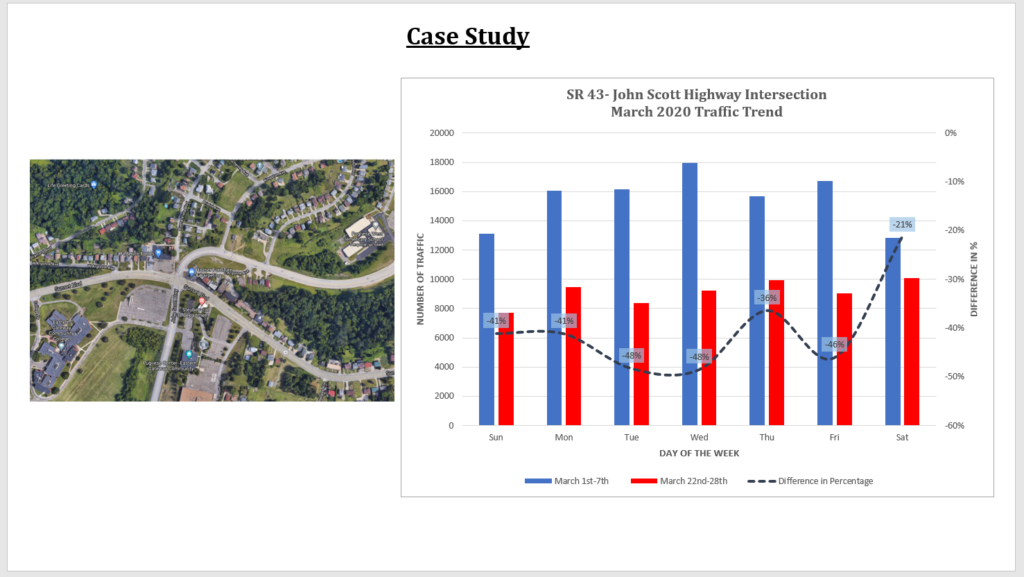
Reduction by Trip Purpose
This study also compared Retail-Recreational trips, Grocery & Pharmacy and Workplace related trips of the region and associated it with the state average. While BHJ region is making lesser “recreational” trips than the states average, “Grocery” and “workplace” trips are still relatively higher than the states. The grocery trip reduction rate is only 1% in Hancock county while they also have the highest work trip reduction rate inside BHJ Region.
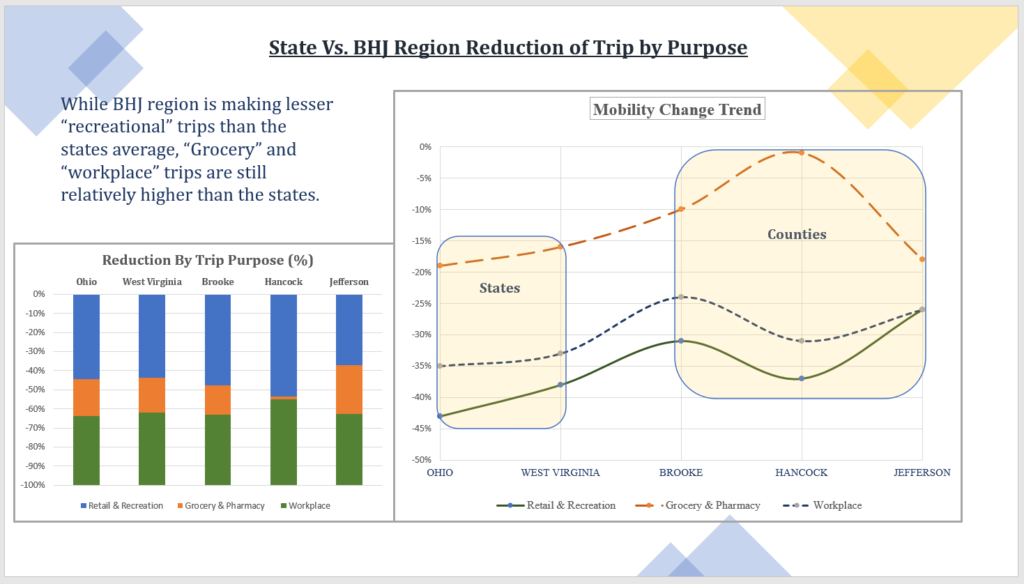
Comparison of trips Between 2019 & 2020
In the next Phase, this study reviewed trip patterns of March 2020 compared to 2019. This comparison reveals some interesting facts about regional travel. It found that, in March 2020, weekday trip decreased only by 3.5%while weekend trip is close to 10%from the trip rate of 2019. Highest “inside county” decrease is found in Hancock county while lowest in Jefferson. When it comes to “cross county” trips, highest decrease is from Jefferson to Brooke 10.3%, lowest Hancock to Jefferson, which is increased by 1 %. Generally, this reduction rate is found more in weekend rather than the weekdays. It is also consistent with the previous findings of this study where it found people are making less recreational trips which generally occur in weekend. While the Home-based Work (HBW) trips are relatively flatter with their previous year’s estimate, there is decrease in Home based other (HBO) and non-home based (NHB) trips. Trip lengths are pretty much consistent throughout the region with 2019 with only exception of a slight increase in Brooke county in longer trips and 2 % decrease of shorter trips in Jefferson County. Throughout the region, people are making relatively less short (Less than 10 Minute) trips which is approximately 2%. Longer trips (More than 30 minutes) increased by 2.5%-3% especially in Brooke County. From the economic view point, this study conducted a traveler’s attribute study and found that people who are making over 75K are doing more trips than their counterparts whose income are less than 20K. The higher purchasing power gives more storing capacity and hence it explained this situation. The level of panic buying in BHJ region was significant after the state emergency declaration. Other than these two lower and upper-income limit, in between income groups are consistent between the two-time frame.
This Longitudinal study of 2019-2020 also explained the decreasing VMT trend of this region for the last couple of years. But because of the availability of jobs and better economy of the country as a whole in the beginning of year 2020, this region started to observe an increase in number of trips people are making from the beginning of January and it lasted until the middle of March 2020, before the state of emergency declaration. The first 15 days VMT of March 2020 is found 32% more than the trip of 2019. But then it decreased, but as the beginning of the month had significant gain over the 2019 march beginning, the overall trend is found to be less significant than many of the major metropolitan areas of Both Ohio and West Virginia.
Some other principal causes that this study identified are –
1. Major employers (healthcare, manufacture, government, construction, warehouse) of this region are all essential business by order definition. Moreover, because of less available service industry employment centers, considered as non-essential, made this situation more static than the previous year. Unlike the large metropolitan areas (population greater than 200,000), overall BHJ employment growth in the retail, food-service, hotel accommodation, and other service industries has been static over last seven to eight years.
2. The majority (92%) of the trips of this region are single occupancy vehicles and most suitable at this moment. The rate of Public transit user is minimal and ride hailing services are absent. In conclusion, this region is not losing vehicle trips related with ride share or public transportation.
3. The low population density and secluded lifestyle in the region creates a sense of safety from the COVID 19.
4. The presence of higher number (20% of total Population) of senior citizens also plays a role and the major trip making the stay at home orders hinder for this demography are Sunday masses.
5. Lack of strong Enforcement.
This study predicts that the trip rate will be steady in the coming days if stay at home orders remain in effect. The low number of COVID-19 cases and the small urban and rural nature in this region is influencing people’s travel pattern, not the governor’s or federal emergency orders.
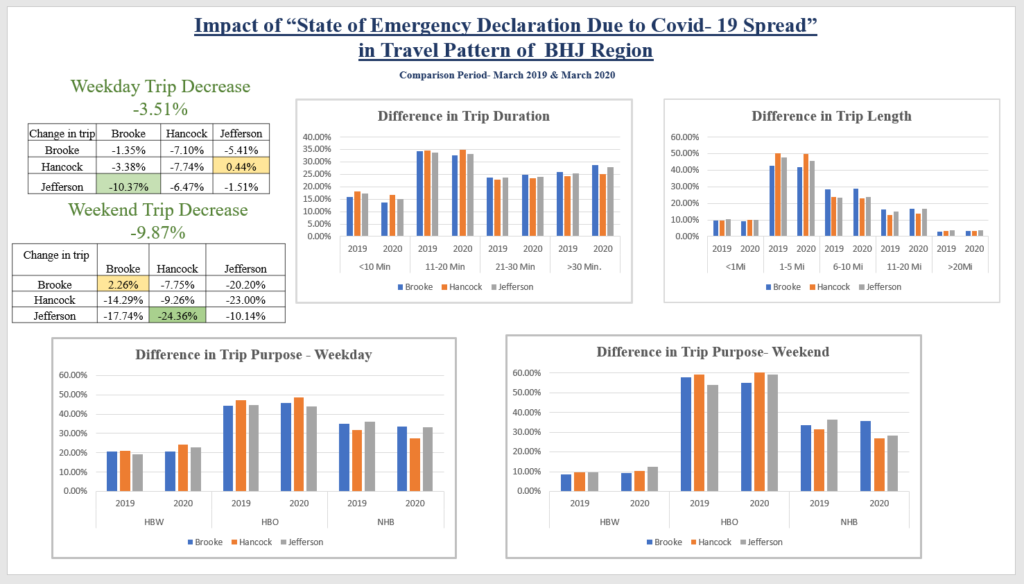
Effect of Different Social Distancing Policy Strategies on Major Ohio Urban Centers
Finally, this study examined trip-making trends in major urban centers of Ohio and found some similar travel trends in BHJ region. The education facility closures played the biggest impact in reducing traffic on road across all of Ohio. By comparison, the larger metropolitan areas experienced an added 20% reduction after the governor issued the Stay at Home Order. This is due to, most likely, the higher presence of non-essential workplaces in the more densely-populated urban areas (population greater than 200,000). Irrespective of the level of affected cases, all the urban centers experienced a significant decrease of VMT. Initially, the emergency declaration order resulted in a greater VMT reduction in Franklin and Hamilton counties, most likely the closure of the state’s two largest universities (Ohio State and Cincinnati). Other areas experienced similar VMT reductions as all other educational facilities across the state began to close. This short delay in response may have played a role in current increase of COVID-19 cases in Cuyahoga, Summit and Lucas counties. The governor’s stay at home order uniformly impact all of Ohio’s major population centers.
